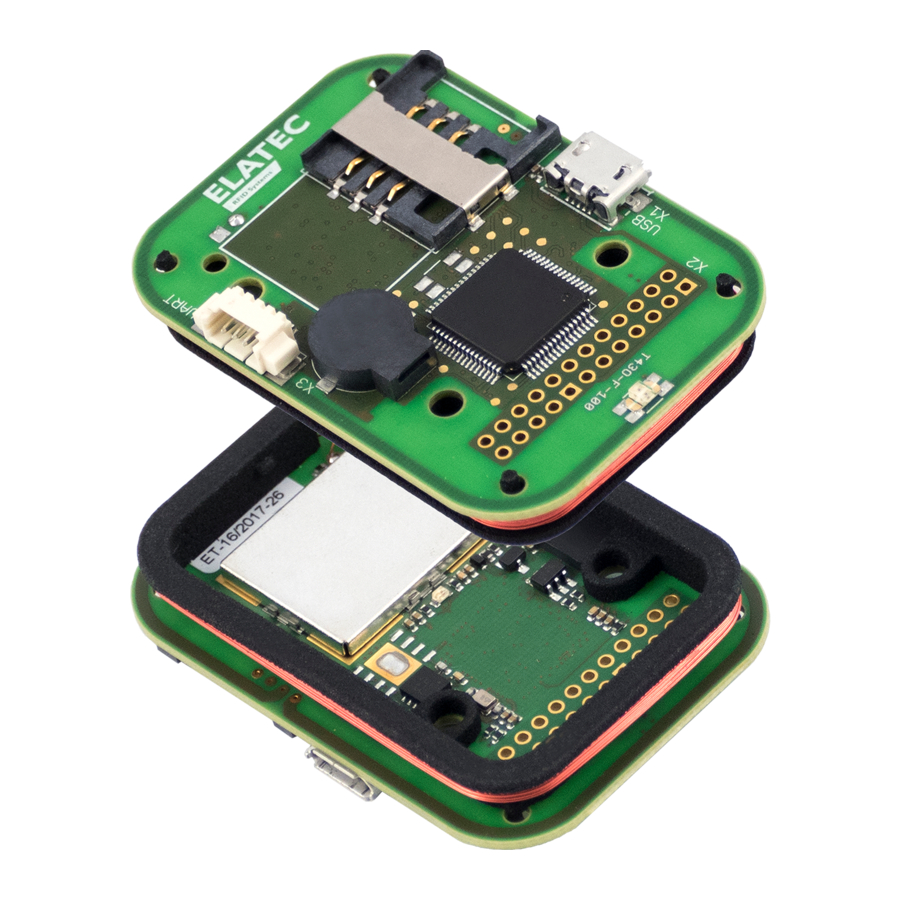
Table of Contents
Advertisement
Quick Links
Advertisement
Table of Contents

Summary of Contents for Elatec TWN4 MultiTech 3 BLE
- Page 1 TWN4 MultiTech 3 BLE Technical Handbook DocRev7, June 17, 2020 Elatec GmbH...
-
Page 2: Table Of Contents
2 TWN4 MultiTech 3 BLE PCB ........ -
Page 3: Introduction
134.2kHz) and high (13.56MHz) frequency antennas, allowing the User access to a wide range of RFID standards. This Technical Handbook provides the details needed to get started using the TWN4 MultiTech 3 BLE: a functional overview of the board, listing the features and interface options available. -
Page 4: Twn4 Multitech 3 Ble Pcb
USB interface. A more generic breakout interface to the main controller is available; its pinout is shown in Table 2.2. The TWN4 MultiTech 3 BLE also offers a SAM slot and a speaker on board. -
Page 5: Dimensions
2 TWN4 MultiTech 3 BLE PCB 2.2 Dimensions Figure 2.2 provides the physical dimensions of the TWN4 MultiTech 3 BLE. All dimensions in mm unless otherwise stated. Figure 2.2: PCB Dimensions Page 5 of 13... -
Page 6: Pinout
The module provides a generic access port that allows the User to bypass the main USB connector and interact with the TWN4 MultiTech 3 BLE microcontroller directly. The port name is X2 and the polarity of its pins is shown in Figure 2.3. The pinout is provided in Table 2.2. - Page 7 2 TWN4 MultiTech 3 BLE PCB Pin Name Function CAN_TX TTL TX pin of CAN interface. An external interface circuit is required. CAN_RX TTL RX pin of CAN interface. An external interface circuit is required. I2C_SCL Clock pin of I2C interface. No internal pull up.
-
Page 8: Uart (X3)
2 TWN4 MultiTech 3 BLE PCB 2.3.3 UART (X3) Pin Name Function 5V supply COM1_RX Low active TTL input with internal pull-up resistor of asynchronous RXD to COM1. COM1_TX Low active TTL output (push/pull) of asynchronous TXD from COM1. Ground Table 2.3: UART connector (X3) Pin Configuration... -
Page 9: Versions
2 TWN4 MultiTech 3 BLE PCB 2.4 Versions Various versions of TWN4 MultiTech 3 are available: One full-featured version and three cost-optimized versions which support LF (125kHz, 134.2kHz) and/or HF (13.56MHz) transponders. Table 2.4 lists the different features of the corresponding model:... -
Page 10: Bluetooth Low Energy (Ble) Feature
Data is sent in bursts, followed by periods of electrical idle. The TWN4 MultiTech 3 BLE uses the BGM121 module from Silicon Labs. The chip implements the Physical, Link and L2CAP Layers of the BLE Protocol. The API is implemented within the firmware of the main TWN4 microcontroller. -
Page 11: Power States And Current Consumption Breakdown
4 Power states and current consumption breakdown The TWN4 MultiTech 3 BLE supports 3 power states that can be used to reduce the current consumption of the reader when the application calls for it. In Normal state the reader can accommodate a request to search for a high-/low-frequency tag, perform a BLE action or interact with peripherals on short notice;... - Page 12 4 Power states and current consumption breakdown Host Connection UART-TTL Typical Consumption in Base System States Normal Idle Sleep Sleep LPCD Option 15,3 0,45 Stop Stop LPCD Option Maximum Consumption by Function wrt. Normal Idle System State SearchTag-HF +140 SearchTag-LF RS232 BLE Active Packet Reception BLE Active Transmission (0 dBm output power)
-
Page 13: Disclaimer
5 Disclaimer 5 Disclaimer Elatec reserves the right to change any information or data in this document without prior notice. The distribution and the update of this document is not controlled. Elatec declines all responsibility for the use of product with any other specifications but the ones mentioned above. Any additional requirement for a specific custom application has to be validated by the customer himself at his own responsibility.










Need help?
Do you have a question about the TWN4 MultiTech 3 BLE and is the answer not in the manual?
Questions and answers